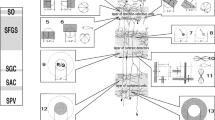Summary
Single unit recording from visual cortex areas 17 and 18 and in the border region between them was performed on adult cats with unilateral optic tract section (OTX) either on the day of the operation (acute) or three to six months postoperatively (chronic). Visual activity from both hemispheres was analyzed with respect to the responsiveness level, the ocular dominance distribution and selectivity to orientation and direction. The results showed almost a complete absence of visual responsiveness in the deafferented hemisphere and a considerable reduction of responsiveness in the intact hemisphere. Following surgery an increase in visually responsive cells was found in the intact hemisphere as postoperative recovery continued. In addition, a reduction in the proportion of cells selective for orientation and direction was also found in the intact hemisphere of the OTX animals as compared to the control cats. Furthermore, cortical binocularity was not affected in the intact hemisphere of all OTX cats.
We conclude that an almost total absence of interhemispheric callosal transfer of visual functions from the intact to the deafferented hemisphere is induced as a result of the unilateral OTX in adult cats. Moreover, the fact that the absence of cortical binocularity in the hemisphere receiving direct geniculate input was not disrupted, indicates the absence of callosal transfer from the deafferented to the intact hemisphere.
Similar content being viewed by others
References
Berlucchi G, Buctel HA, Lepóre F (1978) Successful transfer of visual pattern discriminations in split-chiasm cats with section at the intertectal and posterior commissures. Physiol Behav 20: 331–338
Berlucchi G, Gazzaniga MS, Rizzolatti G (1967) Microelectrode analysis of transfer of visual information by the corpus callosum. Arch Ital Biol 105: 583–596
Berlucchi G, Rizzolatti G (1968) Binocularly driven neurons in the visual cortex of split-chiasm cats. Science 159: 308–310
Choudhury BP, Whitteridge D, Wilson ME (1965) The function of the callosal connections to the visual cortex. Q J Exp Physiol 50: 214–219
Cynader M, Lepóre F, Guillemot J-P (1981) Interhemispheric competition during post-natal development. Nature (Lond) 290: 139–140
Hubel DH, Wiesel TN (1962) Receptive fields, binocular interaction and functional architecture in the cat's visual cortex. J Physiol (Lond) 160: 106–154
Hubel DH, Wiesel TN (1967) Cortical and callosal connections concerned with the vertical meridian of visual fields in the cat. J Neurophysiol 30: 1561–1573
Innocenti GM (1980) The primary visual pathway through the corpus callosum: Morphological and functional aspects in the cat. Arch Ital Biol 118: 124–188
Lepóre F, Guillemot J-P (1982) Visual receptive field properties of cells innervated through the corpus callosum in the cat. Exp Brain Res 46: 413–424
Marzi CA, Antonini A, Di Stefano M, Legg CR (1982) The contributions of the corpus callosum to receptive fields in the lateral suprasylvian visual areas of the cat. Behav Brain Res 4: 155–176
Myers RE (1955) Interocular transfer of pattern discrimination in cats following section of crossed optic fibers. J Comp Physiol Psychol 48: 470–473
Myers RE (1959) Localization of function in the corpus callosum. Arch Neurol 1: 74–77
Payne BR, Elberger AJ, Berman N, Murphy EA (1980) Binocularity in the cat visual cortex is reduced by sectioning the corpus callosum. Science 207: 1097–1099
Shatz C (1977) Abnormal interhemispheric connections in the visual systems of Boston Siamese cats: A physiological study. J Comp Neurol 171: 229–246
Vesbaesya C, Whitteridge D, Wilson ME (1967) Callosal connections of the cortex representing the area centralis. J Physiol (Lond) 191: 79–80
Woolsey CN (1971) Comparative studies on cortical representation of vision. Vision Res Suppl 3: 365–382
Yinon U (1980) Monocular deafferentation effects on responsiveness of cortical cells in adult cats. Brain Res 199: 299–306
Yinon U, Hammer A (1981) Physiological mechanisms underlying responsiveness of visual cortex neurons following optic chiasm split in cats. In: Flohr H, Precht W (eds) Lesion induced neuronal plasticity in sensorimotor systems. Springer, Berlin Heidelberg New York, pp 360–368
Yinon U, Hammer A, Podell M (1982) The hemispheric dominance of cortical cells in the absence of direct visual pathways. Brain Res 232: 187–190
Zeki S, Fries W (1980) A function of the corpus callosum in Siamese cat. Proc R Soc Lond B 207: 249–258
Author information
Authors and Affiliations
Rights and permissions
About this article
Cite this article
Podell, M., Yinon, U. & Hammer, A. Properties of visual cortical cells of the intact and the deafferented hemisphere of unilateral optic tract sectioned acute and chronic adult cats. Exp Brain Res 55, 91–96 (1984). https://doi.org/10.1007/BF00240501
Received:
Revised:
Issue Date:
DOI: https://doi.org/10.1007/BF00240501




